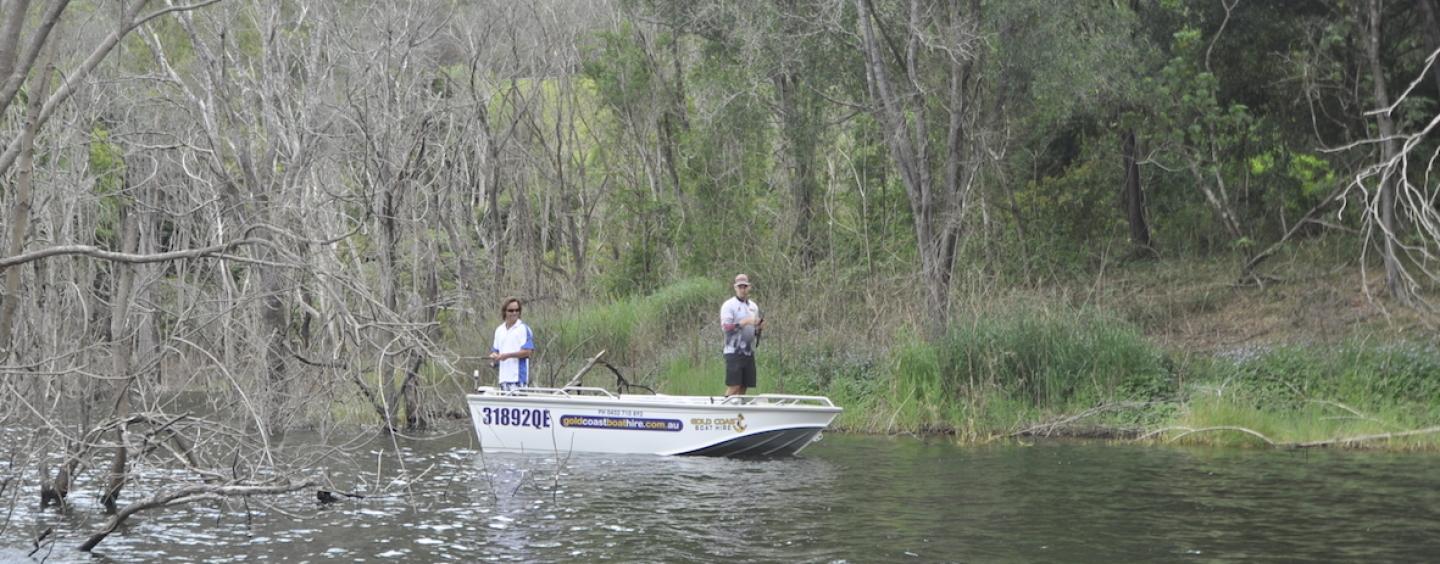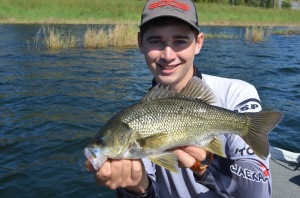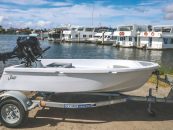Dam fishing has its own perks and challenges. Alex Roy of Sporty’s Fishing in Bundall, a local freshwater fishing expert, shows and tells the Boat Gold Coast team how it is done. The team and Alex set out for bass-fishing at the Hinze Dam as they enjoy the relaxing experience with electric-powered outboard boats.
At six o’clock in the morning, the team meets up at the eastern boat ramp at Hinze Dam. Two electric-powered tinnies, one filled with an expert angler alongside an angler who will also steer, and the other boat carrying an eager crew of photographer and journalist to document it all. Using electric outboards made for a quiet and tranquil fishing experience set in the lush valleys of the Hinze Dam area. The tree structures and kilometres of inlets filled with a vast variety of flora and fauna make the experience very memorable.
The sky is overcast, the water is calm, and the tranquillity is intoxicating. As the boats quietly glide along with singing birds as our background music, the lines are cast and the fisherman single-minded to catch the fish. The morning is all about the dam, the silent boats, and catching the fish.
Dam fishing
“Dams and rivers come with their own challenges,” begins Alex Roy. “Dams are great because they offer a chance to fish for schooled fish resulting in large numbers as they often feed off bait fish. Dam fish are stocked fish, as opposed to wild fish that are found in the rivers. River fishing has its perks as a large part of a river bass’ diet is terrestrial, such as lizards and bugs, which can make for some exciting surface fishing.”
Alex points out that dams are open all year round, while rivers have a close season of three months (from 1 June to 31 August), allowing the bass to bread without being disturbed.
At the Hinze Dam, an angler can expect to catch bass, saratoga, golden perch, Mary River cod and barred grunter. However, it is the bass that feed well all year round. Usually, in winter, they school up in large numbers in deep water. And in summer, they move to the edges feeding on surface bait and terrestrial creatures. So you will catch bass all year round. Saratoga, on the other hand, are more of a summer species.
When recreational fishing, Alex chooses to catch and release the fish. The excitement of catching a bass overpowers the need to eat it. “Bass are a well sought-after sports fish. They fight hard and can be a challenge to catch. I would rather be rewarded with the excitement and the challenge of catching a bass, as opposed to just catching one for a feed. There’s nothing wrong with keeping a legal size bass—minimum of 30cm fork length with a maximum of two fish.” He humours that there are other fish in the sea.
Gearing up for the bass
Alex Roy is a very knowledgeable local fisher. “I don’t think you can necessarily describe the level of skill an angler possesses. It’s one of those things that you can never finish learning or mastering,” he explains. As an angler Alex describes himself as well-rounded, having the ability to target a variety of different species. In the 2012, Alex alongside team mate Tom Slater were crowned ABT bream classic champions, while in 2014 Alex was outright winner of Jackall Bass Moogerah Dam Challenge and has a multitude of top 10 finishes throughout his tournament career.
Fishfinder. Alex recommends using a fishfinder. “Bass will often school, and without a sounder, they are more difficult to find. When the temperature becomes cold they school in large numbers to try and spawn by moving to the brackish water. When it gets too hot, they move to deeper cooler water where the bait is.”
His recommendation is to use a sounder such as a Lowrance HDS Gen3 which is user-friendly and offers clarity. “Concentrate the majority of your searching around gradual points from 4cm to 16cm of water. When looking for fish, sound with DownScan sonar. DownScan provides true clarity and can easily distinguish bass from trees and bait.”
If a fishfinder is not available, Alex recommends finding fish holding structure that are visible such as trees, weeds or rocks. “To find the fish, first find the bait and structure. Throughout the dam, there is structure in the way of trees. So, find the bank through the trees and fish parallel as every bank has the potential.”
Alex advises that technique and strategy varies depending on the season. “During the warmer months, fish the edges with suspending minnows, surface lures, spinner baits, and lipless crank baits.” He points out that the biggest mistake an angler can make when fishing Hinze Dam is to fish the open water.
Bait and Lure. At Hinze Dam, you can use live bait that has been collected from around the dam, for example worms and crickets. However, lure fishing is more convenient and at times more successful. Alex suggests, “Try a 3-in paddle tail soft plastic with a 3/8th oz jig head and ice jigs in winter months, and spinner baits, lipless crank baits, suspending minnows along the surface in summer months.”
For anglers experimenting with lures for freshwater fishing, Alex recommends not to take gear for bait fishing, and try and fish lures. “Lure fishing is all about lightness and sensitivity. A light graphite rod a small reel braided line and a fluorocarbon leader, makes all the difference. People often remark that they’re just fish they won’t know the difference. But trust me, they do. For the angler, a light rod/reel combo allows you to cast light lures accurately and feel timid bites.”
And so, after a quiet relaxing wait by the edges of the dam, Alex finally lands a bass. He showed accuracy and confidence in taking the fish. His tips: “When hooking a bass at Hinze Dam, it is good to fight the fish hard as they stay tight to structure. If the fish turns its head, it may take you back to a snag. So as soon as you have a bite, strike hard and manoeuvre your rod to keep the fish out of the snags. Once you’ve got a bass beside the boat, it’s important to net the fish using an eco-friendly net, then remove the hooks with a pair of long nose pliers while still in the net. Use a pair of lip grips and your hand to support the fish for a photo before releasing.”
Recommended Equipment
RODS: 3-6kg 7 foot spin rod 4-7kg 6’6 bait caster
REELS: 2500 spin reel, 100 bait caster
LINES: 8-16lb braid and 8-16lb leader
For Hinze Dam fishing, Boat Gold Coast recommend:
Our crew were on board a Seajay 3.5 Creek Masta tinnie. As the name suggests, it is a good little boat for sleeking around the tree structures along the dam edges. The cast platform creates storage space and provides a stable platform for flicking a lure. The model also features a mounting plate for electric outboard on the front deck. The boat was supplied by Stefan Boating World.
3.5 Creek Masta – $2675 including GST
Dunbier trailer – $1650 including GST
For the engine, we suggest a Watersnake Venom SXW electric outboard motor with versatile transom-mount that is loaded with a clever feature, such as a 36” shaft on a fast multi-tilt positioning bracket. The three-blade propeller 44lb motor has a telescopic tiller handle for versatility, comfort and control. The electric motor runs of an external 12V 105Amp deep cycle AGM marine battery and offers five forward and three reverse speeds.
Editorial by Andy Kancachian





























